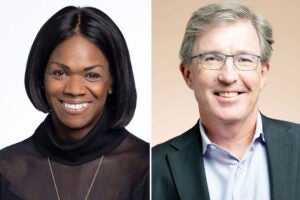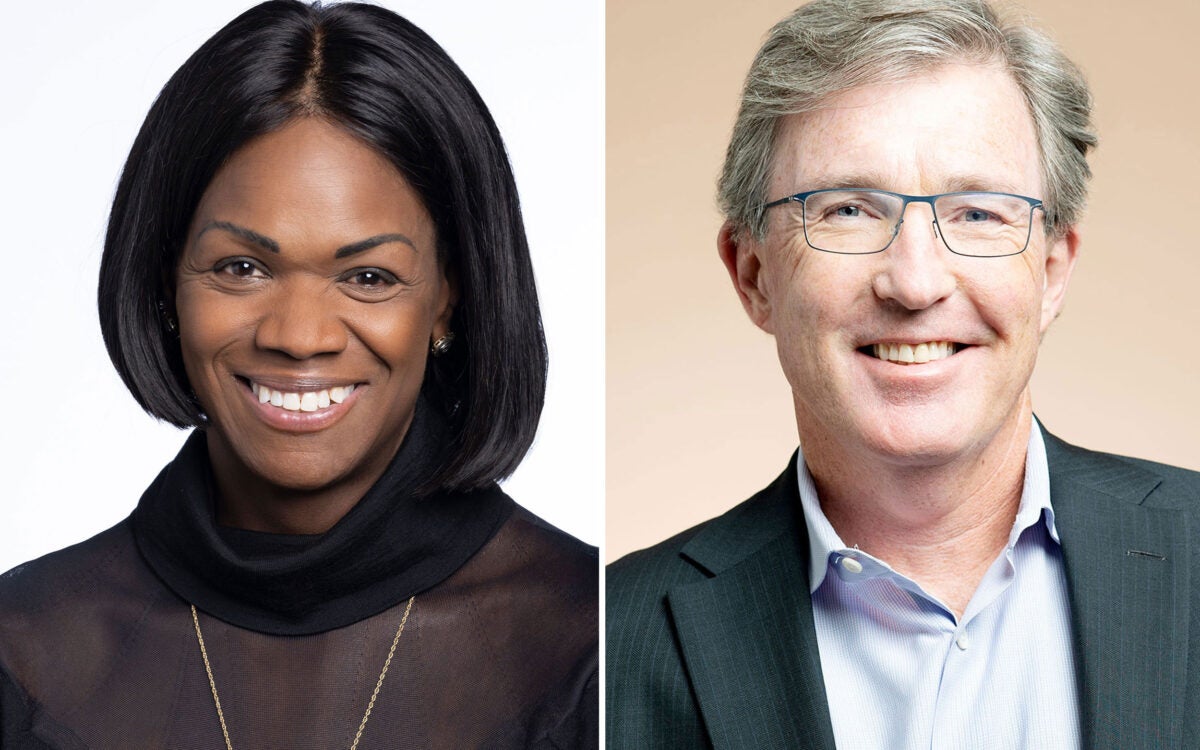Cultivating friendship amid diversity
Harvard Foundation: 16 years of promoting cultural understanding and harmony
When U.N. Secretary-General Boutros Boutros-Ghali came to Harvard in December 1994, he was greeted by a group of Harvard College students bearing flowers. After a reception and luncheon at Leverett House, the diplomat took part in a spirited panel discussion with undergraduates and faculty. Boutros-Ghali departed that evening to a round of student applause.
The festive and intellectually engaging visit was far from a typical day at the United Nations, but it exemplified the kind of programs organized over the past 16 years by the Harvard Foundation for Intercultural and Race Relations.
Since its inception, the Harvard Foundation has worked to promote cultural understanding and harmony among students, faculty, and staff. It has done so through a variety of lectures, debates, dinners, and arts festivals, and through support for student cultural organizations.
“The foundation is a unique and treasured Harvard institution,” says Dean of Harvard College Harry R. Lewis. “It celebrates our racial and ethnic diversity, its programs are inclusive and designed to foster genuine intercultural understanding, and it uses the strengths of our residential system to further these ends. It brings our students together rather than encouraging them to split up. It is mainly student-driven and student-run, and it sponsors lots of events which are interesting or just plain fun!”
Not only did Boutros-Ghali’s visit enable participants to discuss the war in Bosnia and the role of U.N. peacekeeping missions around the world, it illustrated the lengths to which Harvard Foundation Director S. Allen Counter goes to bring distinguished guests of diverse backgrounds to Harvard.
“I spent three years writing the Secretary-General letters about how much it would mean to Harvard students,” says Counter, an associate professor of neurology.
“It was the quintessential foundation program,” he adds. “It included a diverse group of faculty and students, and it touched upon issues relevant to a broad spectrum of the Harvard community. It was educational and enlightening, and it dealt with social issues.”
Encouraging Friendships
The Harvard Foundation began in 1981, amid student demands for a Third World Center.
A special committee appointed by then-President Derek Bok and chaired by the Rev. Peter J. Gomes, Pusey Minister in the Memorial Church, examined the issues and concluded that Harvard would best be served by an organization devoted to improving relations among racial and ethnic groups, rather than by a separate building.
They tapped Counter to be its head, and the foundation was born.
Much has changed since the tumultuous beginnings, when the foundation was boycotted by students unhappy with the University’s solution. For one thing, the agency enjoys a peaceful and productive existence today.
The College has also become increasingly diverse: it attracts undergraduates from many different racial, cultural, religious, and economic backgrounds, and one-third of today’s undergraduates are people of color, noted Senior Admissions Officer David L. Evans, a member of the foundation’s Faculty Advisory Committee.
“You can’t just change the demographics so precipitously (as was done in the late 1960s and early 1970s) and expect this new presence to take care of itself,” he says. “It has to be tended to, and the foundation has done this amazingly well.”
Over the years, the foundation’s programming has grown, as has its funding from the Dean of Harvard College’s office. The number of student organizations it assists has multiplied as well. The Asian American Association, for example, has splintered into about eight different groups, including the Chinese Students Association, the Vietnamese Students Association, the Japan Society, and the South Asian Association.
Harvard College is not immune from the overt and subtle racism that exists in society at large, Counter says. Although most students are eager to mix with a variety of others, there are some who come here with racist views, and people get hurt. But he believes schools like Harvard must confront these problems head-on.
“We’re not going to solve every [racial] problem,” Counter acknowledges. “But we’ve got to create an atmosphere where people are tolerant, respectful, and open to establishing new friendships. The key to good race relations is establishing good friendships. That’s what we want to see more of.”
Some undergraduates continue to press for a multicultural center, but Counter — without criticizing the proponents — suggests that the College itself is such a center.
“Every building at Harvard is a multicultural center where students can host events and express their cultural backgrounds and intellectual interests,” he states. “We should make every place safe and comfortable and welcoming for them.”
From Ashe to Angelou
On virtually any day of the week, the foundation’s office in the basement of Thayer Hall is buzzing. Students from different cultural organizations work on computer terminals, while others prepare materials for upcoming events. Counter, the upbeat, polite, and resourceful director, chats with the undergraduates, whom he typically introduces as “Ms. So-and-so.”
Adorning the walls are posters of famous scholars, artists, athletes, and political leaders who have visited Harvard as guests of the foundation. Among those are Wilma Mankiller, former chief of the Cherokee Nation; Secretary of Housing and Urban Development Henry Cisneros; Nobel Peace Prize laureate Desmond Tutu; the late tennis star Arthur Ashe; writer Maya Angelou; Chinese dissident Harry Wu; Ireland President Mary Robinson; and Hawaii Governor Benjamin Cayetano.
“We select our guests because they’ve done something worthwhile for society, not just because they’re stars,” Counter explains.
One of the most recent visitors was Sinbad, the comedian and actor who hosted Cultural Rhythms, the foundation’s annual showcase of ethnic song, dance, and food.
“I really enjoyed meeting Sinbad; he’s a phenomenal comedian,” says Sarita James ’98, co-chair of the foundation’s Student Advisory Committee. “Few of us had known about his special interest in computer science. He’s worked hard to bring computers to lower-income neighborhoods, and I’m glad we could recognize him.”
Co-chair Nailah Robinson ’98 was thrilled to lunch with actress Phylicia Rashad who, among other roles, played Clair on “The Cosby Show.” “She’s such a role model,” says Robinson. “She is so full of class, grace, style, and dignity.”
To complement the cultural events, the foundation has organized a variety of programs addressing ethnic studies, affirmative action, and other race-related topics over the years. Earlier this month, it cosponsored a conference aimed at attracting minorities and women into science, engineering, and mathematics. The keynote speaker was theoretical physicist Shirley Ann Jackson, a black woman who heads the U.S. Nuclear Regulatory Commission.
Another role of the foundation is to award grants for student-run activities designed to promote greater racial and cultural understanding. This spring, for example, the Student Advisory Committee approved $13,000 for such activities as a Cuban-American dinner, a Japanese fencing seminar, an Arab awareness week, a Native American powwow, and a new magazine called the Harvard Urban and Social Review.
Reaching Out
In an effort to reach as many students as possible, the foundation takes many of its guests to the residential Houses. Quincy House, for example, hosts the annual David Aloian Dinner to honor students, faculty, and staff who have made exceptional contributions to improving race relations.
Leverett House has held a steady stream of foundation events over the years, including a celebration honoring Native American artist R.C. Gorman and a discussion about the political status of Puerto Rico with the island’s governor.
“These have been wonderful occasions,” says Leverett House Master John Dowling. “The Boutros Boutros-Ghali visit was a magnificent day that wouldn’t have happened were it not for the foundation. The whole dining room was filled with interested people.”
Thousands of students have benefited from the foundation’s work over the years, and some have given back after graduation as panelists, donors, and audience members.
Sean Brady ’89, J.D. ’92, was so moved by his experience that he recently sent the Harvard Foundation $5,000 as a token of his appreciation.
“My experience with the foundation was the highlight of my years at Harvard,” writes Brady, who was active in the Irish Cultural Society here. “Through the foundation I was able to meet and work with outstanding students and faculty from all cultural and racial backgrounds, and to participate in a broad range of projects, from Puerto Rican Week to the North Pole Family Reunion. The experience enriched my education immeasurably, and I am indeed grateful.”
Said Gomes, “Little did I realize when I responded to a summons from President Bok in 1980 to chair a committee on a ‘Third World Center’ that nearly 20 years later I would be celebrating the extraordinary accomplishments of the Harvard Foundation. It had a troubled birth, and few gave it much hope.
“But the quite remarkable powers of Dr. Counter have brought a dream into reality. I take credit for the motto ‘To enhance our common life,’ but it is Dr. Counter and generations of Harvard students and faculty colleagues who have translated that motto into institutional reality.”




